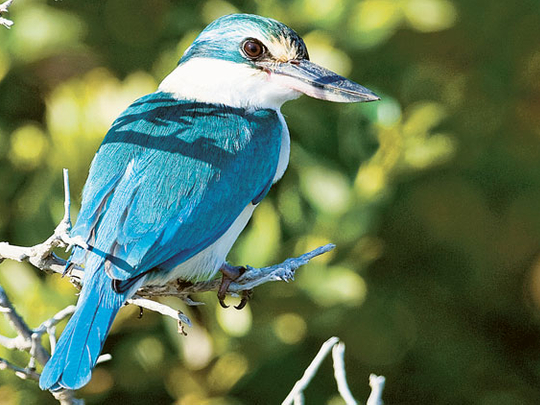
Al Ain: The population of Kalbaensis, the sole species of kingfisher found in the UAE, is declining due to habitat destruction, a recent survey reveals.
As the Kalba Mangroves in Khor Kalba — the bird's natural habitat — along the Gulf of Oman face several threats, the numbers of these beautiful and rare birds are falling swiftly.
The blue-green coloured bird with a white belly is considered one of the rarest in the world and has lived in isolation from other kingfisher species found in South and East Asia.
It is the UAE's native bird and is named Halcyon Chloris Kalbaensis after its sanctuary. It is more commonly known as the Kalba Collared Kingfisher or Kalbaensis.
"It's an endangered species," said British birdwatcher Oscar Campbell who is one of three members of the survey team. He added that all of the bird's three habitats are threatened.
Kalbaensis has its nesting grounds in Khor Kalba in the UAE and two smaller ones in Shinas and Liwa on the Batinah coastline just across the border in Oman, Campbell said.
Campbell and his Emirati partner Ahmad Al Ali, a nature photographer and Regional Representative of the Ornithological Society of the Middle East, recently gave a presentation titled The Birds of Khor Kalba in Al Ain.
The presentation included the results of their survey and census conducted to ascertain the population of the endangered Kalbaensis. The survey was funded by a research and conservation grant from the Emirates Natural History Group (ENHG).
The presentation was hosted by the Al Ain Chapter of the ENHG.
Campbell said the bird's population may have decreased up to 27 per cent and only 35 to 40 pairs of Kalbaensis were spotted during the survey.
"That's not too bad… still reasonable... but it shows a big decline," he said.
The mangroves are, however, decreasing. And that has been affecting their population, said Campbell who has been an ardent birdwatcher since his boyhood.
The bird was first spotted in 1995 by Simon Aspinall, a UAE-based British birdwatcher, as a new subspecies found nowhere else but in the UAE and Oman. He surveyed the bird's population, reporting just 44 to 55 pairs at that time.
Campbell is a chemistry teacher at a school in Abu Dhabi. In his free time he serves as a guide for visiting birdwatchers, contributes to ornithological publications, submits bird records online and serves as the chairman of the Emirates Bird Records Committee (EBRC).
Development a threat
Khor Kalba is part of the emirate of Sharjah and the centre of lots of new infrastructure developments.
"Land reclamation and changing hydrology are two serious threats to the Kalbaensis and to the centuries-old mangroves," Campbell said.
The UAE has 40 sq km. of mangroves out of which six sq km are in Kalba. Many old Avicennia marina trees are located in Khor Kalba.
Khor Kalba, Campbell said, is a natural reserve and a home to rare birds, fish and a great variety of plants. It is also an important re-fuelling stop for migratory birds that come from Siberia, Europe, the Indian subcontinent and other places.
Campbell said immediate measures are needed for the protection of the birds and their habitat.
"If it is allowed to deteriorate, an important bird habitat will be lost that is critical for the survival of some rare bird species," he added.
He said Kalbaensis, unlike other kingfishers, nests in the old trees' trunks and branches and prefers crabs and snails over fish.
"This species appears to tolerate a high degree of disturbance by human intrusion and falling quality of the mangroves," he said.
A recently built water channel near the mangroves has downgraded the quality of the habitat.
Camel grazing in the area, oil spills, cutting of mangrove trees, air pollution, and new constructions in the area are serious threats. Similar problems exist in the Omani areas as well.
Campbell said the Sharjah authorities are keen to protect the bird and its habitat. In a recent meeting they said the area has great potential if managed properly.












